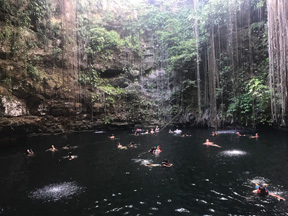Cenote
TS’ONOT JAPAN, MEXICO / 2019 / Mayan, Spanish / Color / DCP / 75 min
JAPAN, MEXICO / 2019 / Mayan, Spanish / Color / DCP / 75 min
Director, Script, Photography, Editing: Oda Kaori
Narration: Araceli del Rosario Chulim Tun
Sound: Augusto Castillo Ancona
Sound Design: Nagasaki Hayato
Executive Producer: Echigoya Takashi
Producers: Marta Hernaiz Pidal, Jorge Bolado, Oda Kaori
Presented by: Aichi Arts Center, Cine Vendaval, Fieldrain
Produced by: Aichi Prefectural Museum of Art
Source: Oda Kaori
www.fieldrain.net
In the northern Yucatán Peninsula of Mexico, there is an abundance of cenotes—underground springs that flow into caves. In the ancient Mayan empire, these were the only source of water, and they were also where ceremonies were held to pray for rain. This film tells the story of the people, past and present, whose lives intersect with the cenotes, which are believed to be the connection between this world and the next. Swimming fish, children, elders, festivals, bull fights, faces . . . In this bewitching film of light and darkness, flowing together with the water we hear the echoes of ancient memories, the voices of spirits, and lines from ancient Mayan plays.
[Director’s Statement] Cenotes are natural underground springs in Mexico’s northern Yucatán Peninsula, numbering in the thousands. When I told a Mexican friend I wanted to film the ocean, she advised me that her country also has beautiful springs and told me about the cenotes. In the course of my research, I discovered their deep relationship with the ancient Maya people.
To experience them for myself, I moved from one village to another like I was on a road trip, going down into cenotes that varied size and shape from ones that looked like just a well a family might use, to those that were connected to the sea. On my way I asked people living near cenotes about their memories and traditions with regard to them, and their relationship with the Maya. One person, upon learning of our research, recited something, which was apparently from a play performed for the purpose of sustaining Mayan culture and tradition. My film Cenote was completed through an accumulation of these encounters: a series of opaque, half-asleep and half-awake moments, both in the water and on dry ground.
After people see Cenote they often ask if I like being underground, because in my previous documentary I went down into a coal mine, and in this one the main locations were underground caves full of water. Perhaps, quite apart from wanting to get a glimpse at unfamiliar worlds, I also feel that by going down into the bowels of the earth I might be able to touch ancient and long forgotten layers of human memory.
Filmmaker and artist, born in Osaka, 1987. Through image and sound, she explores human memories (voices)—where we come from, and where we are going. In 2010, her medium-length film Thus a Noise Speaks received the Audience Award at Nara-wave, the student film competition of the Nara International Film Festival. In 2013, she joined Film Factory, a training program for young filmmakers led by film director Tarr Béla, in its first year, completing the program in 2016. Her first feature-length film Aragane (2015), focusing on a Bosnian coal mine, was awarded a New Asian Currents Special Mention at YIDFF 2015. In 2017, her second feature-length film Toward a Common Tenderness (2017) had its world-premiere at DOK Leipzig.
